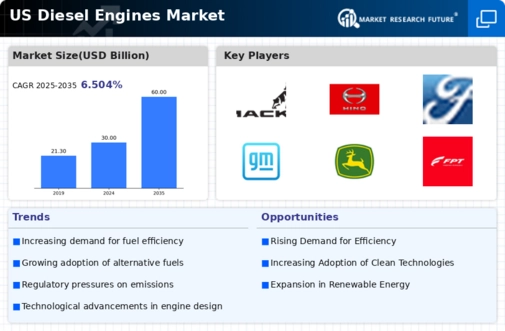Infrastructure Development and Investment
Infrastructure development and investment in the US are key drivers of the diesel engines market. The government has prioritized infrastructure projects, including road construction, bridges, and public transportation systems, which often require diesel-powered machinery and vehicles. In 2025, federal and state investments in infrastructure are expected to exceed $200 billion, creating a robust demand for diesel engines. This influx of capital is likely to stimulate growth in the diesel engines market as manufacturers respond to the increased need for reliable and efficient engines to support these projects. The long-term outlook suggests that sustained infrastructure investment will continue to bolster the diesel engines market.
Technological Advancements in Engine Design
Technological advancements in engine design are playing a crucial role in shaping the diesel engines market. Innovations such as turbocharging, direct fuel injection, and advanced fuel management systems are enhancing engine performance and efficiency. These developments not only improve fuel economy but also reduce emissions, aligning with regulatory requirements. The integration of smart technologies, such as telematics and predictive maintenance, is also becoming prevalent, allowing operators to optimize engine performance and reduce downtime. As these technologies continue to evolve, they are expected to attract investments and drive growth in the diesel engines market.
Regulatory Compliance and Emission Standards
The diesel engines market is experiencing a notable shift due to stringent regulatory compliance and emission standards imposed by the US government. These regulations aim to reduce harmful emissions and promote cleaner technologies. As a result, manufacturers are compelled to innovate and develop engines that meet these standards, which often leads to increased operational costs. The Environmental Protection Agency (EPA) has set forth guidelines that require diesel engines to reduce nitrogen oxides (NOx) and particulate matter (PM) emissions by up to 90% by 2027. This regulatory landscape is driving investments in research and development, thereby influencing the overall dynamics of the diesel engines market.
Rising Demand in Transportation and Logistics
The diesel engines market is significantly driven by the rising demand in the transportation and logistics sectors. Diesel engines are favored for their fuel efficiency and durability, making them ideal for heavy-duty vehicles such as trucks and buses. In 2025, the transportation sector accounts for approximately 70% of diesel fuel consumption in the US. This trend is expected to continue as e-commerce and freight transportation grow, leading to an increased need for reliable diesel-powered vehicles. Consequently, manufacturers are focusing on enhancing engine performance and efficiency to cater to this expanding market, which is likely to bolster the diesel engines market.
Increased Adoption in Agriculture and Construction
The diesel engines market is witnessing increased adoption in the agriculture and construction sectors, where reliability and power are paramount. Diesel engines are preferred for heavy machinery, such as tractors, excavators, and generators, due to their ability to deliver high torque and withstand demanding conditions. In 2025, the agricultural sector is projected to account for a significant share of diesel consumption, driven by the need for efficient farming equipment. Similarly, the construction industry relies heavily on diesel-powered machinery for various applications. This growing reliance on diesel engines in these sectors is likely to sustain demand and support the overall growth of the diesel engines market.
























Leave a Comment